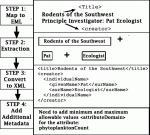Approaching a Dream
Implementing Ecological Metadata Language at LTER Sites to Facilitate Cross-site Synthesis
Ecological Metadata Language (or EML), is a content standard implemented in XML for documenting ecological data. If EML is used at the time the data is recorded, it will “reduce the time required to standardize data —months or years after it has been collected —and will facilitate research at larger scales of time and space” (see “Ecological Metadata Language Increases Research Capability” by John Porter, in The Network Newsletter Vol. 15 No.1 Spring 2002).
At a workshop in June 2002, the LTER Information Managers expressed the desire for on-site consultation rather than a group workshop to implement EML. Beginning in December 2002 and continuing over the next several months David Blankman of the LTER Network Office is working directly with the information managers at their sites to implement EML. So far, David has visited Niwot and McMurdo sites in Colorado, the Florida Coastal Everglades, and the Coweeta and Georgia Coastal Ecosystem LTER sites, to convert their legacy text-based metadata to EML. Meanwhile, a team from Central Arizona-Phoenix LTER site (CAP) will work with those sites that have metadata stored in relational database systems.
The purpose of visits is to assist LTER site information managers in the conversion of legacy metadata to EML and to help the information managers develop systems that will automatically produce EML compliant metadata. As a new LTER site, FCE provides the opportunity to design a system that meets all of the site’s internal needs and will be optimized to produce EML.
The conversion of legacy metadata (text-based, i.e., not in a relational database) to EML is a four step process (see Fig. 1).
Visits for the near future include PIE, HFR, HBR, ARC, and BES, as well as Cedar Creek and Luquillo. The CAP team will be assisting the other sites. North Temperate Lakes LTER site is already generating EML dynamically.
As part of the move toward standards and to facilitate cross-site synthesis, the Network Office is organizing a workshop to be held this spring. The purpose of this workshop will be to develop a recommendation that might be called LTER EML Core.
LTER EML Core will address issues such as:
- EML is a very flexible and comprehensive standard; the smallest valid EML document would include only a title, and two last names. The largest EML document could contain thousands of separate fields. What should LTER’s minimal EML document contain?
- With EML there are different ways to document the same information. What should the LTER approach be?
- EML and LTER Researchers: What’s in it for me?
The LTER Network is currently in the investment phase of EML. Resources will be needed to convert legacy metadata into EML. Resources will also be needed to continue the development of software to enter, search, and retrieve metadata documents store in EML format.
So, what’s the payback? As anyone who has participated in an NCEAS synthesis workshop knows, doing synthetic research in ecology is tedious. Often more time and effort is spent finding and then converting heterogeneous data into a common format, than is spent on the actual synthetic research.
The Present: The software to allow for search and retrieval of relevant data is now available for EML compliant metadata.
The Near Term: Once the vast quantity of legacy LTER metadata is converted to EML and stored in EML aware network catalogs, researchers will be able to do targeted searches for data of interest.
The Future: The true power of EML will emerge in the next decade as intelligent software agents are developed to aid in the integration of ecological data. Through these exercises, we are getting close to Rudolf Nottrott’s dream (ca 1993): I was lying on the beach. I had a research idea. I picked up my smart phone, spoke my research question. The smart phone tapped into my personal data gathering research software agent which searched the web, retrieved the relevant data, sent it to my analytical agent, which then tested the hypothesis. My paper-writing software agent wrote and then submitted a paper to Science for review... And then I woke up.
EML and LTER Researchers: Ask not what EML can do for me, but what you can do for EML. While the EML implementation team can assist the site information managers in the technical aspects of converting legacy metadata to EML, virtually all sites will need to add additional metadata. The site information managers will, in most cases, need to consult with site researchers to help in the generation of the new metadata.

 Enlarge this image
Enlarge this image